3 Myths: Dogs Eating Grass In Norfolk, Va

Dogs love eating grass, and they do it very regularly. Grass often smells very sweet, has a unique texture, and waves gently in the breeze, which makes it irresistible to a curious furry friend. However, that curiosity has also given rise to several myths surrounding dogs eating grass, including potential explanations for the behavior that simply isn’t true. Here are a few myths you may have heard, as well as some tips to make sure it’s safe for your dog.
Myth 1: Your dog Is trying to induce vomiting
This myth likely arose because dogs often vomit immediately after consuming grass. A dog’s teeth aren’t very good at cutting up pieces of grass, so when the dog swallows, they’re likely to be swallowing long pieces of whole grass. This triggers their very sensitive gag reflex, allowing them to regurgitate the grass easily. However, there’s no evidence to suggest that dogs understand this process and are actively trying to induce vomiting when they eat grass. It’s more likely that they just enjoy eating it and accidentally trigger a vomiting reflex.
Myth 2: Your dog has pica
One possible condition your dog may deal with is pica, which is a behavioral disorder that causes a dog to compulsively eat non-food items. These items can vary, including wood, stones, plastic, and, yes, grass. However, a dog occasionally eating some grass is normal, while pica is fairly rare. If you spot your dog eating grass, this doesn’t mean they have pica. Pica would only be a potential problem if your dog was regularly and obsessively eating it.
Myth 3: Your dog has a nutritional deficit or a parasite
This myth may have come about because pet owners worried that a dog would only eat grass if they weren’t getting enough nutrition. Dog owners wondered whether their food was providing enough nutrition or if a parasite was stealing that nutrition away. The good news is that there’s no evidence to suggest eating grass is correlated with having any nutritional issues. Dogs likely just enjoy eating grass, and there are other more effective markers of parasitic infection or nutritional concerns that you should turn to before assuming grass eating is one of them. Also Read – Can Dogs Eat Nuts And Raisins?
How to make grass eating safer
First, remember to check that the grass your dog is eating isn’t treated with anything. Chemical treatments can make grass unsafe for dogs, including treatment with pesticides and other chemical formulas, such as some fertilizers.
It’s also important to be familiar with poisonous plants in Norfolk that your dog might be eating instead of grass. Some common plants to watch out for include foxglove, poison ivy and poison oak, milkweed, and English ivy. You might see these plants in gardens, in the wild, or as decorative plants within a home. All of them can be dangerous to your dog, and you should avoid them.
Finally, remember that if you’re concerned about your dog’s health, you can talk to a Norfolk veterinarian to get more information about what might be happening. Even if you just want to soothe your nerves over your dog’s health, talking to a veterinarian is a great way to be sure that everything is okay.



